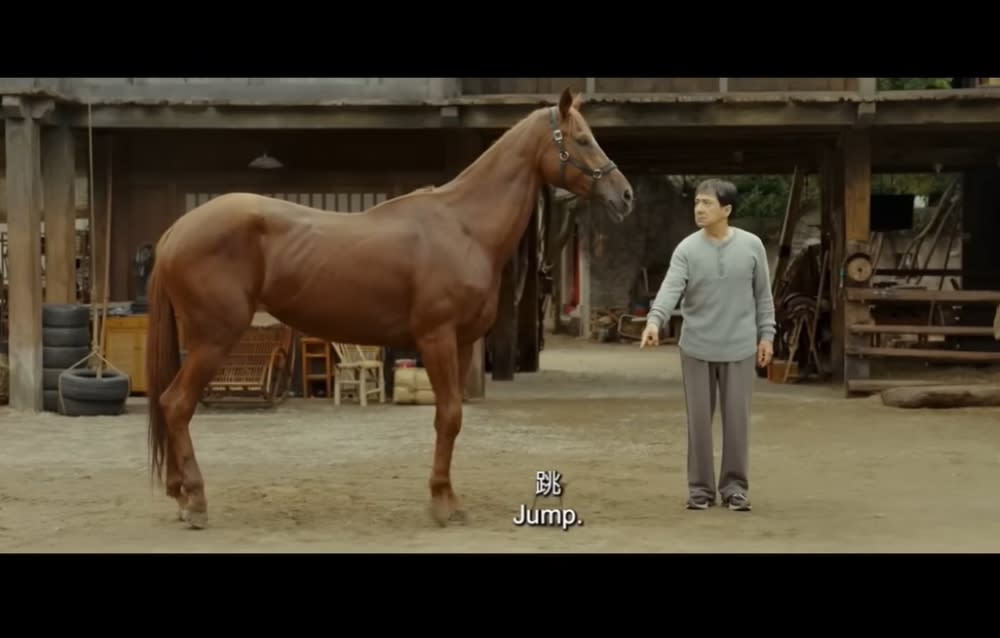 Malay Mail
Malay Mail‘Ride On’: A passionate ode to stuntmen

APRIL 24 — In the past, I enjoyed Jackie Chan movies for mainly one reason: the action.
Last week, I found myself moved by his latest instalment, Ride On, for different (yet ironically similar) factors.
Note: This review contains no spoilers.
The movie portrays the struggles of an ageing stuntman, Master Luo (Chan), who is wrecked with debts, an estranged daughter Xiao Bao (played by up-and-coming actress Liu Haocun) and a beloved stunt-horse whom he may be forced to give up.
The film essentially sees Luo struggling to fulfil the stunt demands of various directors while trying his best to be the dad he never was to Bao in between fending off debt collectors.
It is noteworthy that the main debt collector is played by Andy On whom we first saw in New Police Story almost 20 years ago where he was the chief martial arts protagonist to Chan’s super-cop character.
That’s how much time has flown between the two movies.
Anyway, for die-hard Chan fans, Ride On is one of very few films in the past 10 years which features the stunts and trade-mark action choreography Jackie is known for.
It was joyously nostalgic to see him fighting bad guys again using cups, tables, ladders and chairs.
The outtakes at the end of the film reveal that Chan was injured in at least one scene; imagine a 70-year old guy falling from a roof after fighting with a rocking chair (beat that, Tom Cruise!).
Having said that, I’m willing to bet one movie ticket that for this movie at least, Chan used a stunt double (gasp!).
In the past, each time Chan’s character did something death-defying (like crash a car or fall off a 60-foot clock tower) the camera ensures his face is visible to leave no doubt that that’s actually him.
In Ride On, in quite a few action scenes his face is hidden. This, ironically resonates with the central theme of the movie which is about how traditional stunt-work (and thus stuntmen) may be obsolete given the emergence of CGI, the lack of trained people willing to risk their bodies, and changing audience preferences.
Director Larry Yang knows this perfectly well and milks it for all the destruction it causes to the reality-fiction barrier.
Unless you’re in your teens and have no idea what Jackie Chan has been doing since your parents were in their teens, you would surely pick up on the fact that the story of Master Luo is really Chan’s own story.
Any traditional Chan fan, like me, would have trouble separating Luo’s fictional struggles from Chan’s real-life woes.
Luo was once a celebrated stuntman but now, being old, he has trouble getting good projects and even has money problems.
Except for the money part, one could argue that Chan is in a similar boat. Luo wrecked his body for his work and, as per a quote in the movie, he ”fights with his life for what he loves”; Chan has broken hundreds of bones during filming and even almost died when jumping onto a tree when shooting Armour of God in 1986 (see note 1).
More poignantly, Luo throughout the movie tries hard to reconcile with a daughter who hated him for abandoning her when she was young; Chan has this exact problem in real life, too.
The broken father-daughter relationship is explored in Ride On with the kind of depth no early Chan movie would have done. This, and the deep bond between Luo and Red Hare (his horse), is the reason why many will find it impossible to not shed a tear.
Apart from 2004’s New Police Story I swear I have never seen Chan’s character sob that much. With all due respect to Chan’s acting abilities, I am of the view that many of the tears shed by Chan in this film over his daughter are real (see note 2).
Perhaps this reflects Yang’s genius and is the key factor why the movie is doing so well in the box-office.
Yang knows that today’s audiences want authenticity and dramatic profundity (it’s hard to not love a movie which makes you cry non-stop), two qualities the early Jackie Chan knew almost nothing about.

Jackie Chan in a scene from ‘Ride On’. — Screen capture via YouTube/ONE Media
Finally, a note about the horse which, although was the key attraction in the trailers and posters, remains merely the medium (not the message).
All credit to Yang and Chan for weaving a story with a delightful animal at its core. This movie’s main themes (about the obsolescence of limb-risking stuntmen) could easily have been made without a horse, but there you go.
Not only do you have a visual anchor for the movie (which works rather well), you also get a creative stunt-theme (many of the action scenes revolve around Red Hare) plus seriously powerful kicking hoofs.
Some reviewers said this movie was depressing. I don’t agree. It’s not a “great” movie but I think an ageing action star and a creative young director came up with a good idea to showcase an issue in the Hong Kong film industry — and do so in a way which leaves audiences cheering and sobbing even harder.
Note 1: There are montages of Chan’s stunts from his early films sprinkled throughout this movie. Younger audiences who’ve never seen those sequences from the 80s and 90s are in for a treat.
Note 2: Ride On isn’t the first movie where Chan struggles to reunite with a “lost” daughter. In the 2017 movie Bleeding Steel, Chan’s character also tries to play an important (albeit hidden) part in the life of his daughter, a daughter who doesn’t know her father. Coincidence?
* This is the personal opinion of the columnist.


